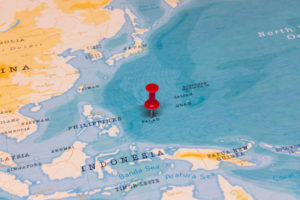 The Department of Defense has been tight-lipped about the installation of a long-range over the horizon radar in the strategic Republic of Palau. The radar, known as the Tactical Mobile Over-the-Horizon Radar, or TACMOR, will be able to pick up space-based and terrestrial-based sensor and weapon systems for the potential cueing and early warning of incoming hypersonic weapons, cruise missiles, ballistic missiles, enemy aircraft, and ships. Read the PAF 198127 TACMOR UTILITIES AND INFRASTRUCTURE SUPPORT release from Sam.gov:
The Department of Defense has been tight-lipped about the installation of a long-range over the horizon radar in the strategic Republic of Palau. The radar, known as the Tactical Mobile Over-the-Horizon Radar, or TACMOR, will be able to pick up space-based and terrestrial-based sensor and weapon systems for the potential cueing and early warning of incoming hypersonic weapons, cruise missiles, ballistic missiles, enemy aircraft, and ships. Read the PAF 198127 TACMOR UTILITIES AND INFRASTRUCTURE SUPPORT release from Sam.gov:
The work for this project includes the construction (Design-Bid-Build) of infrastructure and utilities to support a system of research antennas. The work includes electrical utilities, reinforced concrete pads and foundations, tie downs for equipment, water and wastewater, access roads, paved parking and turnaround areas, two levels of security fencing, and extensive site work to provide a complete and useable project in support of the installation of the Tactical Mobile Over-the-Horizon Radar (TACMOR) equipment. The equipment (not in contract) includes transmission and receiver antennas at two locations and equipment for calibration and Maritime Domain Surveillance System (MDSS). The facilities will be designed as semi-permanent construction is accordance with the DoD Unified Facilities Criteria (UFC) 1-201-01, Non-Permanent DoD Facilities in Support of Military Operations.
The magnitude of this project is estimated between $100 million and $250 million. The North American Industry Classification System (NAICS) Code is 237990 Other Heavy and Civil Engineering Construction, average annual receipts is $39.5 million over the past three years. The contract completion period is anticipated to be 1,106 calendar days. This acquisition will be procured on an unrestricted basis, inviting all qualified firms to submit price and technical proposals.
U.S. Military Priorities Quickly Shifting in the Pacific
Activities by the U.S. in Guam, Tinian, Palau, and other islands in the region have been on the rise. The development of TACMOR for Palau and Aegis for Guam, strongly communicate the growing shift in the U.S. military’s priorities in the Pacific. During the Valiant Shield exercise, the Air Force experimented with A-10 Warthogs and C-130s. The A-10s could be used to launch MAPLDs, and the C-130s could be used to employ the Rapid Dragon System in the Pacific. Emma Helfrich and Tyler Rogoway of The Warzone write (abridged):
Palau is an independent country with an established history with the United States under the 1994 Compacts of Free Association (COFA) agreement, which governs the military relationship between the two nations. The U.S. military has been making significant use of Palau’s islands for various military exercises over the years including this year’s Valiant Shield 2022.
The Valiant Shield exercise saw the first-ever launch of a Patriot surface-to-air missile system in Palau — a system that could be vital to protecting TACMOR during a conflict. The Air Force also used this opportunity to experiment with A-10 Warthogs and explore the ways that the aircraft could operate from distributed locations, like Palau’s Roman Tmetuchl International Airport. Angaur Airfield on Palau’s island of Angaur has also been deemed suitable for C-130 aircraft to operate from as an alternative to the country’s airport.
Activities on and around Guam, Tinian, and other U.S. islands in the region have also been conducted. These islands have all become hotspots for U.S. military infrastructure expansion in recent history. Guam specifically is a U.S. territory and the Missile Defense Agency (MDA), the Army, and the Navy have together been working on new air and missile defense capabilities on the island, which can be read about in detail in this past War Zone piece.
In fact, the MDA just awarded Lockheed Martin a contract worth $528 million that expands upon the company’s existing Aegis Weapon System to implement integrated air and missile defense capabilities into an Aegis Guam System. This capability will allow U.S. forces to engage ballistic threats with SM-3 interceptors at various points in the missiles’ flight paths, though other interceptors like the SM-6 and the forthcoming Glide Phase Interceptor could eventually be integrated into Aegis Guam as well.
A THAAD battery has also existed on Guam for years, and this would likely be integrated with the Aegis system to provide an additional layer of ballistic missile defense. Other missiles could be integrated and deployed to counter the cruise missile threat to the island, too. There are, however, geographical factors that go into building facilities like Aegis Guam and TACMOR on these relatively small and mountainous islands.
Regardless, even though the station has yet to be completed, knowing that the development of TACMOR for Palau is progressing strongly communicates the growing shift in the U.S. military’s priorities in the Pacific.
Steve Schneider
Latest posts by Steve Schneider (see all)
- New Chinese Electromagnetic Surveillance Leaves “Nowhere to Hide” on Battlefield - March 15, 2024
- Amazon’s Nuclear Powered Data Center - March 7, 2024
- Skunk Works Rolls Out An Engineering Marvel - March 6, 2024
- Future of Airpower Takes First Flight - March 4, 2024
- A War Beneath the Waves – Trillions of Dollars at Stake - February 9, 2024















